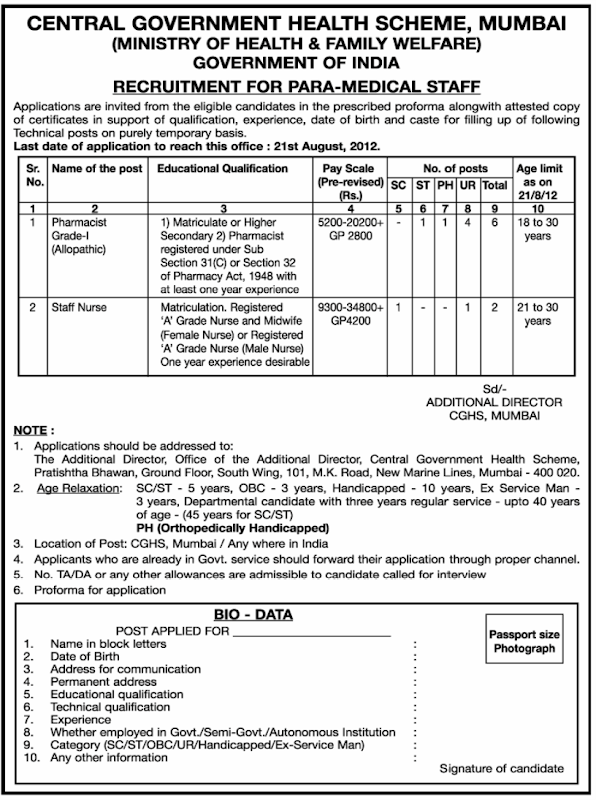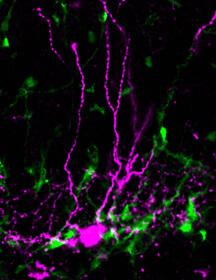
Advt. No.18/2012
The National Institute of Pharmaceutical Education & Research (NIPER) is an Institute of national importance established by an Act of Parliament under the aegis of Department of Pharmaceuticals, Ministry of Chemicals & Fertilizers, Government of India. The main thrust areas of the institute are Tuberculosis, Malaria, Leishmaniasis and Diabetes. The Institute has excellent facilities for advanced education and research in pharmaceutical sciences and technology and is looking for faculty of high caliber and potential, willing to face the challenge of building this Institute into a center of excellence.
The Institute intends to fill the four (04) posts of Professor (UR: 02, OBC: 01 & SC: 01) in the following disciplines.
Post: Professor- (Biotechnology-01, Pharmacokinetics-01, Advisor - Business Development- 01, Technology Development of APIs and Dosage Formulations- 01)
1. PROFESSOR (BIOTECHNOLOGY):
The incumbent should have worked in one of the frontier areas of biotechnologyspecializing in cell and molecular biology, stem cells, tissue engineering, cell differentiation and growth etc. addressing the issues of regenerative medicine and developmental biology.
ESSENTIAL QUALIFICATION & EXPERIENCE:
Ph.D with first class or equivalent grade at the preceding degree in the appropriate branch with a very good academic record throughout and at least 10 years of teaching/research/industrial experience with published work of high quality well recognized and established reputation of having made conspicuous seminal contribution to knowledge in pharmaceutical and allied areas.
DUTIES:
In addition to teaching courses and supervising students, the incumbent has to provide leadership for implementing newer approaches in the emerging areas of advanced research.
PAY STRUCTURE:
PB-4 (Rs.37,400 - 67,000/-) with starting pay Rs.48,000/- pm plus Academic Grade Pay of Rs.10,500/- and other allowances at par with Central Government Rules.
MAXIMUM AGE LIMIT:
50 years (relaxable for specially qualified candidates).
2. PROFESSOR (PHARMACOKINETICS):
The institute is looking for a dynamic and result oriented person for the post of Professor (Pharmacokinetics). The incumbent must have post-doctoral training or relevant job experience in DMPK, PK PD modeling / simulation that may relate to development of drug therapies, drug targets, or drug delivery systems. Preference will be given to applicants with training and research expertise in areas of bio-pharmaceutics, BA-BE, or pharmacokinetics / clinical pharmacokinetics. Candidates
with experience in drug metabolism and pharmacokinetic modeling or clinical research are especially encouraged to apply.
ESSENTIAL QUALIFICATION & EXPERIENCE:
Ph.D with first class or equivalent grade at the preceding degree in the appropriate branch with a very good academic record throughout and at least 10 years of teaching/research/industrial experience with published work of high quality well recognized and established reputation of having made conspicuous seminal contribution to knowledge in pharmaceutical and allied areas.
DUTIES:
In addition to teaching courses and supervising students in pharmaceutics, clinical research and drug metabolism, the incumbent will be responsible for managing 24-bed bioequivalence unit (National Bioavailability Centre) of the Institute and providing BA BE inputs and services to in-house projects and Indian Pharma Industry. The candidate is also expected to pursue and establish appropriate research collaborations within the Institute, Pharma or Biotech companies and engage in scholarly activity.
PAY STRUCTURE:
PB-4 (Rs.37,400 - 67,000/-) with starting pay Rs.48,000/- pm plus Academic Grade Pay of Rs.10,500/- and other allowances at par with Central Government Rules.
MAXIMUM AGE LIMIT:
50 years (relaxable for specially qualified candidates).
3. PROFESSOR (ADVISOR - BUSINESS DEVELOPMENT)
The institute is looking for a dynamic and result oriented person for the post of Professor (Advisor - Business Development). The incumbent should have the exposure to pharmaceutical industry and shall possess the ability, capability and to cope up with the requirements and expectations of the institute. He is expected to be a person with positive attitude, capable of problem solving, with a proven ability to coordinate with the industry, set interaction with the niche area clients (both within India and abroad), explore contract research opportunities, licensing of generated know-how / services, consultancy arrangements etc. and in general research management / business development activities of the institute
ESSENTIAL QUALIFICATION & EXPERIENCE:
Ph.D with first class or equivalent grade at the preceding degree in the appropriate branch with a very good academic record throughout and at least 10 years of teaching/research/industrial experience with published work of high quality well recognized and established reputation of having made conspicuous seminal contribution to knowledge in pharmaceutical and allied areas.
DUTIES:
The duties of the incumbent would be to promote business development, business in public – private partnership, contract research, industrial liaison, management of IPR portfolio, transfer of know-how, promotion / linkages of activities of the proposed SME Centre at NIPER and other activities as advised by the Board of Governors from time to time.
PAY STRUCTURE:
PB-4 (Rs.37,400 - 67,000/-) with starting pay Rs.48,000/- pm plus Academic Grade Pay of Rs.10,500/- and other allowances at par with Central Government Rules.
MAXIMUM AGE LIMIT:
50 years (relaxable for specially qualified candidates).
4. PROFESSOR (TECHNOLOGY DEVELOPMENT OF APIs& DOSAGE FORMULATIONS):
The incumbent should have experience in scale up, process / product translation or development and validation activities in the areas of drugs and pharmaceuticals either in new dosage formulations or APIs or both. Experience in setting up, operating and managing pilot plants, process control equipments including analytical laboratories would be an added advantage.
ESSENTIAL QUALIFICATION & EXPERIENCE:
Ph.D with first class or equivalent grade at the preceding degree in the appropriate branch with a very good academic record throughout and at least 10 years of teaching/research/industrial experience with published work of high quality well recognized and established reputation of having made conspicuous seminal contribution to knowledge in pharmaceutical and allied areas.
DUTIES:
The selected candidate shall have the responsibility of managing the existingTechnology Development Centre (TDC) for APIs and upcoming dosage formulations plant and provide its clients, full range of services as an industrial developmental support upto bio-batches or clinical batches.
PAY STRUCTURE:
PB-4 (Rs.37,400 - 67,000/-) with starting pay Rs.48,000/- pm plus Academic Grade Pay of Rs.10,500/- and other allowances at par with Central Government Rules.
MAXIMUM AGE LIMIT:
50 years (relaxable for specially qualified candidates).
PB=Pay Band, AGP= Academic Grade Pay
Application should be accompanied with non-refundable fee of Rs.500/- (Rs.250/- in case of SC/ST) in shape of Demand Draft drawn in favour of Director, NIPER payable at Mohali/Chandigarh.
Application duly filled in prescribed form should be sent to Director, National Institute of Pharmaceutical Education & Research, Sector-67, S.A.S. Nagar (Mohali)-160062.
OTHER AMENITIES/ALLOWANCES
The faculty of NIPER shall be entitled to Dearness Allowance, Medical Allowance, House Rent Allowance, Transport Allowance, LTC and other allowances etc. In addition, the faculty of the Institute shall be given the following special allowances to help them in their professional development.
MEMBERSHIP OF PROFESSIONAL SOCIETIES/PROCURMENT OF JOURNALS
The faculty member shall get 50% subsidy on the cost of membership or of the journals up to a maximum of Rs.5,000/- per year.BOOK ALLOWANCE
The faculty member shall get a book allowance upto maximum of Rs. 5,000/- per year. The books shall ultimately form a part of the Institute’s Library accession.
CONTRACT RESEARCH & CONSULTANCY
The Institute encourages the faculty members to undertake consultancy work or work on sponsored projects.
GENERAL INFORMATION
1. Mere eligibility will not entitle any candidate for being called for interview. The Institute reserves the right to place reasonable limit on the total number of candidates to be called for interview.
2. The Institute reserves the right to withdraw advertised post(s) at any time without assigning any reason. Institute also reserves the right to fill or not to fill the post(s) and its decision in this regard shall be final.
3. Reservation policy will be followed as per Government of India rules. The candidates are required to attach valid caste certificate as per format prescribed by the Government of India.
4. The process of selection may include presentation / seminar / interview or a combination thereof.
5. Envelope containing the application form must be super scribed with ‘Application for the post of ______________ (discipline applied for)’.
6. Applicant(s) serving in Government / Semi-Government / Public Sector Undertakings/ Autonomous organizations must send their application ‘Through proper channel’.
7. The names, addresses and occupations of the two referees must be given in the application.
8. The age of Superannuation will be as per UGC norms.
9. Candidates shall have to produce original testimonials at the time of interview.
10. CANVASSING IN ANY FORM MAY LEAD TO CANCELLATION OF CANDIDATURE.
11. No interim enquiries/correspondence/communication of any sort will be entertained on the matter.
12. All appointments are contractual in nature for a period of five (05) years or attaining the age of superannuation, whichever is earlier. The contract can be renewed depending upon performance and mutual consent. However, except for the consequences of being on contract, the position filled on contract shall accrue all the benefits of permanency as per rules of NIPER.
13. Incomplete application or without relevant supporting enclosures (self attested copies of degree / certificates / marks sheets / experience certificate, reprint of important publications etc.) will be out-rightly rejected.
14. How to Apply: Application form is available at <below>. The candidates fulfilling the eligibility criteria may submit their application on the prescribed application form along with testimonials and latest passport size photograph along with a fee of Rs.500/- (Rs. 250/- for SC/ST) in the shape of Demand Draft favouring Director, NIPER, payable at Mohali / Chandigarh to Director, NIPER, S.A.S. Nagar – 160 062.
15. The last date for receipt of application form is 08-10-2012.
16. The Institute will not be responsible for non-receipt of application(s) within the stipulated date due to any postal delay / loss of application / document sent in transit.
Application Form
 CENTRAL DRUGS STANDARD CONTROL ORGANIZATION, Under the Drug and Cosmetics Act, the regulation of manufacture, sale and distribution of Drugs is primarily the concern of the State authorities while the Central Authorities are responsible for approval of New Drugs, Clinical Trials in the country, laying down the standards for Drugs, control over the quality of imported Drugs, coordination of the activities of State Drug Control Organisations and providing expert advice with a view of bring about the uniformity in the enforcement of the Drugs and Cosmetics Act.
CENTRAL DRUGS STANDARD CONTROL ORGANIZATION, Under the Drug and Cosmetics Act, the regulation of manufacture, sale and distribution of Drugs is primarily the concern of the State authorities while the Central Authorities are responsible for approval of New Drugs, Clinical Trials in the country, laying down the standards for Drugs, control over the quality of imported Drugs, coordination of the activities of State Drug Control Organisations and providing expert advice with a view of bring about the uniformity in the enforcement of the Drugs and Cosmetics Act. 













 Parents are increasingly conscious of the dangers of childhood obesity. There is a growing recognition of health problems associated with extra pounds, including the risk of diabetes, heart disease, and joint and muscle pain.
Parents are increasingly conscious of the dangers of childhood obesity. There is a growing recognition of health problems associated with extra pounds, including the risk of diabetes, heart disease, and joint and muscle pain. 

